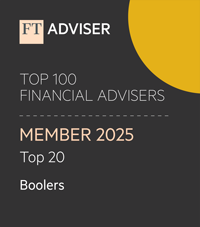Reveal Menu
Market Commentary: Monthly Bulletin February 2023

Prabhdeep Gill









After a relatively positive start to the year, markets pared back their gains in February, following a series of growth, labour market and inflation surprises which sparked fears that interest rates may peak at a higher level than investors first anticipated.
(All figures are based on bid-to-bid pricing with income reinvested, in Sterling terms)
US
The US Federal Reserve raised its benchmark interest rate by 25 basis points, bringing the Federal Funds Rate to be between 4.5% – 4.75%. The slower rate rise indicates that in the Fed’s view inflation has peaked, and economic growth has begun to slow down in certain sectors of the economy. In his press conference, Fed Chair Jerome Powell cited disinflation 13 times, stating that there had been some encouraging signs that price pressures were easing. He also reiterated that ongoing increases in interest rates would be needed to help bring price pressures under control, to ultimately hit their target inflation rate of 2%. In the aftermath of Federal Reserve raising rates, traders and investors are now pricing in a peak in interest rates at 5% and a cut in interest rates by 0.5% by the end the year.
However, strong economic data on growth and inflation released later in February indicated the US economy is currently experiencing robust economic growth, a hot labour market and sticky inflation. This was shown by stronger than expected retail sales for the month of January and 500,000 new jobs created in January. The Federal Reserve’s preferred measure of inflation, the personal consumption expenditures (PCE) price index, which measures how much consumers are paying for goods and services, increased at an annual rate 5.4% in January, up from the month prior 5.3%. The strong economic data is significant, as the Federal Reserve are currently data dependent in their thinking and if the trend of sticky inflation continues, it will give them more ammunition to continue to raise interest rates further.
UK
UK markets performed relatively well in February as shown in the chart above, with the FTSE 100 trading above 8,000 before falling back at the end of month. Additionally, UK mid cap companies fared well and have been leading the way this year in developed equity markets. The UK market is attractive based on relative valuations, high dividend yields and a value bias in defensive/cyclical sectors and such market characteristics tend to do well when there is higher inflation and higher interest rates. This is encouraging to see and justifies our overweight in UK equities across our model portfolios.
On the economic front, annual inflation stood at 10.1% for the month of January, a fall from the previous month of 10.5%, with most of the decrease being due to the decline in energy and food costs. In their monetary policy report, the Bank of England indicated that the UK will now experience a much milder recession than first anticipated and implied that ongoing interest rate rises would not be needed, unless there were new signs in the economy that inflation may be persistent. The Bank estimates that inflation will fall to a level around 4% by the end of the year and will drop below its 2% target rate in Q1 2024. Investors have now trimmed back their bets of continuing rate hikes on the back of the dovish comments from the Bank of England and they now see interest rates peaking at around 4.5%, with economists split 50/50 as to whether we will see one or two more rate hikes by 0.5%.
Europe
European equities performed resiliently despite concerns from investors that the European Central Bank (ECB) will have to be more aggressive in increasing interest rates to curb rising inflation.
Consumer prices in France and Spain rose by 7.2% and 6.1% year on year respectively in February, with price pressures seen in goods, services, energy and food. This has created doubts in investors’ minds as to how quickly the ECB will stop raising rates, as the latest figures suggest overall Eurozone inflation may be more persistent with the rate currently at 8.6%. The ECB has already committed to a 0.5% increase in its deposit rate in their upcoming meeting on the 16th of March, which would see its benchmark rate rise to 3%, with markets pricing in rates to be at 4% by year end.
Asia & Emerging Markets
Asia & Emerging Market equities sold off in February as the boost regarding China’s economy re-opening faded as investors reassessed valuations, particularly in Chinese consumer names that had an additional uplift from pent-up demand, since the rally began in October last year. However, valuations in Asia and Emerging markets continue to look attractive, particularly when compared to valuations in developed markets and earnings per share estimates are likely to be upgraded over the long-term starting from a lower base. This is particularly the case in companies that were able to cut costs and improve their operating leverage and hence recover their margins, which should provide a long-term fundamental tailwind for Asian equities.
Japan
Similarly in Japan, investors took a pause in the equity market, following the recent rally, as they considered how the new governor of the Bank of Japan (BoJ) is likely to position monetary policy over the long-term. Latest inflation data showed Japan’s core inflation rate which excludes volatile food prices reached a 41-year new high of 4.2% in January, as the cost of commodity imports increased.
Furthermore, companies are reporting wage increases across a broad range of industries and investors are questioning whether the BoJ can sustain 2% inflation or whether wage increases are the second derivative that will continue to spur domestic demand and hence growth and price pressures in economy. This would force the BoJ to pivot their stance on monetary policy easing and therefore would result in companies operating in value orientated sectors outperform companies that are in more growth parts of the market. We continue to be overweight in Japan, blended and diversified between different investment styles, as the best way to manage risk and provide steady returns in this region.
Portfolio Changes
This month we reinvested the profits from the sale of iShares FTSE 100 ETF holding into fixed income, buying the Premier Miton Strategic Monthly Income OEIC. The main reason for increasing our exposure to fixed income was to lock in higher attractive yields, following the selloff in bonds last year, and to provide greater diversification with our equity exposure.
THE BOOLERS INVESTMENT COMMITTEE
“At Boolers, you know that things will be dealt with properly and professionally. A real safe pair of hands!”
“I have always found the quality of advice, technical knowledge and level of service is second to none. ”
“Thank you to all of you for such a wonderfully smooth transaction! Hope we can do it again some time.”
“Boolers provided excellent advice when we needed it most.”
“Boolers have provided myself, family and business with pension and investment advice for over 30 years and continue to provide a high quality professional service to us all on an ongoing basis.”
“Chris Ball has been our Financial Adviser for many years and, from the start, we have been impressed with his strategic sense, his deep knowledge and his skills in helping us build our own successful retirement. He understands our aims and how to achieve them and has taken great care of us throughout. ”



